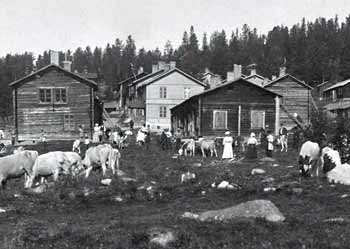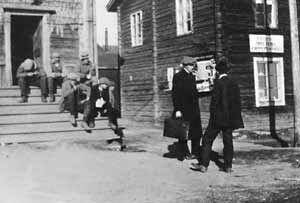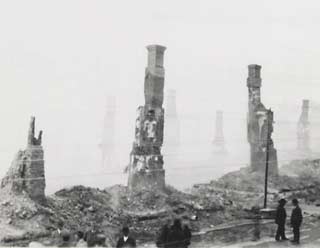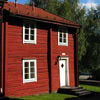Vilhelmina Church town
Church towns are a mainly Northern Swedish phenomenon that in some places date back to the middle ages or the 15th century. Having church towns to stay in was a necessity for churchgoers, considering the vast parishes they often had to travel through to get to church.
Attending a church weekend could take several days. Farmers therefore needed somewhere to spend the nights. Consequently people had to build little wooden towns that were only populated during the church weekends. Up in the mountains there were more typical Sami church towns that mainly consisted of Sami huts.
The Church Town and Church Weekends in Vilhelmina

Vilhelmina church town fair. © Vilhelmina museum
The Vilhelmina church town was built in the 1840’s when an area on the church’s land, at the foot of the Church Mountain (Kyrkberget), was set aside for building a church town.
Farmers often joined forces to build a cottage where each household got the right to dispose of one or two chambers. The chambers and cottages were often named after their owner’s village, like Råselestugan (Råsele cottage), Nol-om myr’n-kammaren, Hacksjökammaren etc. The last cottage was supposedly built in the mid 1890's. The church stables were situated north of the church town.
Up until the middle of the 19th century, church attendance in Sweden was regulated by law. But even though attendance was obligatory, most people welcomed the church weekends as they meant a pause in their otherwise monotonous and strenuous everyday lives. Besides attending church, people got the opportunity to meet friends and relatives, who gladly shared news and gossip from other villages and parishes.

© Västerbottens museum
In temporary shops, stands and coffeehouses people could buy beautiful things, strong beverages and other things that couldn’t be produced on the home farm. Sometimes the drinking during the weekends got out of hand. The “dreadful drunkenness” in the church town squares is a constantly recurring topic in the old documents.
In between church weekends, all church cottages were barred and bolted. At the end of the 17th century this principle was abandoned and the cottages began to have more permanent residents, mostly out-of-towners and people who didn't own their own property. This led to the establishment of permanent businesses in the church town. Slowly the Vilhelmina church town square was turning into a community.
The Fire of 1921

© Vilhelmina museum
In the morning of September 5th 1921, one of the cottages south of Storgatan caught fire. Its old timber walls burned easily and the fire quickly spread from house to house. The fast spreading fire was further assisted by people throwing furniture, household utensils and other objects in between the houses, which then caught fire and sped up the process. In this sea of fire the villagers had only three fire engines at their disposal. By five o’clock in the afternoon it was clear that all of the buildings on the south side of Storgatan, about 50 houses, had burnt to the ground. It was later established that the fire had been caused by a faulty chimney wall.
The Church Town is Rescued
In time, the remaining church cottages on the north side of Storgatan began to decay and it was obvious that something had to be done if the historically valuable settlement was to be enjoyed by future generations. In the 1960’s, the municipality of Vilhelmina therefore started buying the old houses in an attempt to restore them. This restoration was finished in 1975. From having originally solely been used as private homes and business premises’, the church cottages were now being rented out as boarding for passers through. Presently, a second restoration of the church town and a face lift of the surrounding area is under way.
- Spend a night in Vilhelmina Church Town!

Would you like to experience a night in the old Church Town? Please contact
Vilhelmina Tourist Agency
tel:+46 (0)940-398 86.